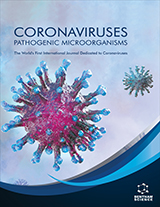Abstract
Background: SARS-CoV-2 emerged in Wuhan in December 2019, and after that, it spread quickly around the world. The virus could spread to millions of individuals since there were no particular treatments or preventative measures. The COVID-19 infection is often treated with current drugs such as Remdesivir, steroids, tocilizumab, favipiravir, and ivermectin. However, the immunosuppressive effects of these medicines might worsen COVID-19 symptoms and put the lives of immunocompromised individuals in peril. Thus, it is important to sustain a robust immune system when undergoing therapy for COVID-19. Herbal treatment has the potential to accomplish this objective.
Objective: The current investigation involves the preparation of polyherbal syrup containing various medicinal plants such as ephedra, diascorea, ginger, echinacea, garlic, rhubarb, and glycyrrhiza for the effective control of the COVID-19 infection.
Methods: All varieties of the individual plant powders (200 g) were treated to a 7 day maceration in aqueous ethanol (70:30) in a percolator at room temperature with intermittent vigorous shaking at room temperature and storage of the extract in a dark room. The mixture was run through a muslin cloth and then a Whatman qualitative grade 1 filter paper to produce the filtrate. The filtrate was evaporated to a thick paste-like consistency at 370°C under decreased pressure in a rota evaporator connected to a vacuum pump. After that, each individual extract was collected and kept in airtight jars at 4°C. According to the Indian Pharmacopoeia, simple syrup (66.67% w/v) of polyherbal extract was prepared. The oral administration of polyherbal syrup was carried out at varied doses of 0.5 ml, 1 ml, and 1.5 ml to infected golden Syrian hamsters from the 7th day for one week after infection reached its peak.
Results: When compared to the infection control group, the results revealed that the viral load was significantly reduced by 79.1% when treated with polyherbal syrup. A histological examination of the infected hamster lung on days 7, 10, and 13 demonstrated that polyherbal syrup significantly decreased viral load in a dose-dependent manner.
Conclusion: It is inferred that the polyherbal syrup formulation demonstrates efficacy in the prevention of COVID-19 infection during its first stages and may serve as a potential contender for SARSCoV- 2 due to its immunomodulatory properties.
Graphical Abstract
[http://dx.doi.org/10.3390/biom11030371] [PMID: 33801280]
[http://dx.doi.org/10.14704/nq.2020.18.2.NQ20141]
[http://dx.doi.org/10.1016/B978-0-323-85542-6.00003-2]
[http://dx.doi.org/10.1073/pnas.2021579118] [PMID: 33452205]
[http://dx.doi.org/10.3389/fphar.2021.746729] [PMID: 34721035]
[http://dx.doi.org/10.2147/JEP.S411939] [PMID: 36941894]
[http://dx.doi.org/10.14348/molcells.2020.0177] [PMID: 33199671]
[http://dx.doi.org/10.3390/molecules24193505] [PMID: 31569633]
[http://dx.doi.org/10.1007/s11418-021-01596-w] [PMID: 35006524]
[http://dx.doi.org/10.3390/molecules28020663] [PMID: 36677722]
[http://dx.doi.org/10.3390/biom11010042] [PMID: 33396926]
[http://dx.doi.org/10.1021/acs.jnatprod.2c00736] [PMID: 36399766]
[http://dx.doi.org/10.1039/D1RA00644D] [PMID: 35479175]
[http://dx.doi.org/10.15835/nbha46210918]
[PMID: 35784200]
[http://dx.doi.org/10.1016/j.csbj.2021.08.029] [PMID: 34426762]
[http://dx.doi.org/10.1128/JVI.03427-14] [PMID: 25589660];
b) Roberts A, Vogel L, Guarner J, et al. Severe acute respiratory syndrome coronavirus infection of golden Syrian hamsters. J Virol 2005; 79(1): 503-11.
[http://dx.doi.org/10.1128/JVI.79.1.503-511.2005] [PMID: 15596843]
[http://dx.doi.org/10.1128/JVI.00304-08] [PMID: 18463152]
[http://dx.doi.org/10.1086/500143] [PMID: 16453264]
[http://dx.doi.org/10.1016/j.fct.2022.113438] [PMID: 36179993]
[http://dx.doi.org/10.1101/2022.10.31.513793]
[http://dx.doi.org/10.1016/j.coviro.2015.06.009] [PMID: 26184451]
[http://dx.doi.org/10.1101/2022.05.16.492112]
[http://dx.doi.org/10.1080/07391102.2021.1871863] [PMID: 33526003]
[http://dx.doi.org/10.1080/17512433.2021.1903317] [PMID: 33706626]
[http://dx.doi.org/10.1016/j.antiviral.2022.105371] [PMID: 35777669]
[http://dx.doi.org/10.1016/j.rbmo.2020.06.001] [PMID: 32651106]
[http://dx.doi.org/10.1073/pnas.1518240113] [PMID: 26903655]
[http://dx.doi.org/10.1101/2020.08.20.259721]
[http://dx.doi.org/10.7150/ijbs.45123] [PMID: 32226289]
[http://dx.doi.org/10.1016/j.virusres.2020.197989]
[http://dx.doi.org/10.1016/j.jtcme.2020.05.004] [PMID: 32691006]
[http://dx.doi.org/10.1016/j.imr.2020.100407] [PMID: 32289016]
[http://dx.doi.org/10.3906/biy-2005-114]
[http://dx.doi.org/10.1021/np9800102] [PMID: 9722499]
[http://dx.doi.org/10.1186/s40169-017-0181-2] [PMID: 29340951]
[http://dx.doi.org/10.1016/S2666-5247(20)30089-6] [PMID: 32838346]
[PMID: 22040504]
[http://dx.doi.org/10.1039/C4MB00164H] [PMID: 25000319]
[PMID: 24199575]
[http://dx.doi.org/10.1155/2014/151235] [PMID: 25506380]
[http://dx.doi.org/10.1080/13880200701585865]
[http://dx.doi.org/10.3906/biy-0912-30]
[http://dx.doi.org/10.1016/j.micres.2009.09.002] [PMID: 19840899]
[http://dx.doi.org/10.1016/j.phrp.2016.11.003] [PMID: 28053847]
[http://dx.doi.org/10.3390/antibiotics9040207] [PMID: 32344551]
[http://dx.doi.org/10.3390/ijms20133328] [PMID: 31284572]
[http://dx.doi.org/10.1016/j.chom.2018.01.006] [PMID: 29478775]
[http://dx.doi.org/10.1038/s41564-019-0371-3] [PMID: 30804542]
[http://dx.doi.org/10.1155/2016/5460302] [PMID: 27672241]
[http://dx.doi.org/10.1016/j.tibs.2016.09.002]
[http://dx.doi.org/10.2174/0929867324666170227121619] [PMID: 28245768]
[http://dx.doi.org/10.3390/cancers11111736] [PMID: 31694340]
[http://dx.doi.org/10.1016/j.antiviral.2007.10.011] [PMID: 18055026]
[http://dx.doi.org/10.1016/B978-0-12-814619-4.00018-5]
[http://dx.doi.org/10.1016/j.jmii.2011.09.030] [PMID: 22154993]
[http://dx.doi.org/10.1080/22221751.2020.1746199] [PMID: 32196410]
[http://dx.doi.org/10.1155/2012/256294] [PMID: 22536270]
[http://dx.doi.org/10.1038/cr.2013.92] [PMID: 23835475]
[http://dx.doi.org/10.1002/jmv.25719] [PMID: 32083328]
[http://dx.doi.org/10.1159/000508247] [PMID: 32392562]
[http://dx.doi.org/10.1101/2020.05.23.104919]
[http://dx.doi.org/10.3389/fimmu.2020.00026] [PMID: 32117225]
[http://dx.doi.org/10.1146/annurev-virology-110615-042301] [PMID: 27578435]
[http://dx.doi.org/10.1016/j.pop.2013.06.004] [PMID: 23958368]
[http://dx.doi.org/10.4193/Rhino14.239] [PMID: 26030031]
[http://dx.doi.org/10.4103/lungindia.lungindia_225_17] [PMID: 29319033]
[http://dx.doi.org/10.1136/adc.58.7.500] [PMID: 6307189]



























